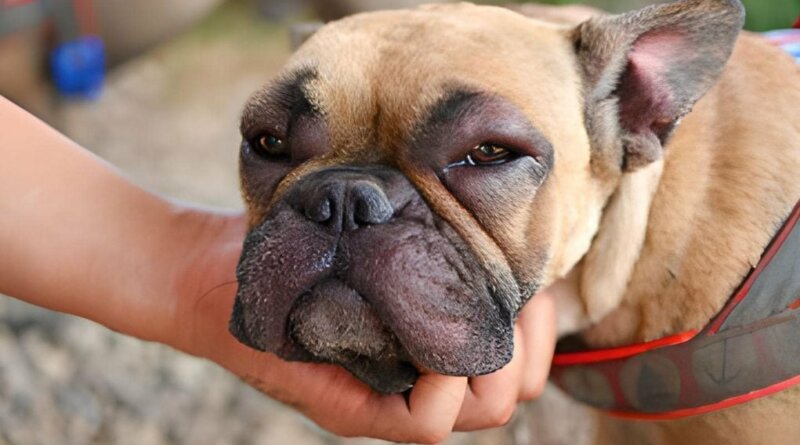First Aid, Treatment, and Prevention – Top Dog Tips
Has your dog suddenly started yelping due to pain? Chances are a cunning bee is to blame.
Bee stings are very painful, and dogs cannot communicate that they have been stung.
Keep in mind that bee stings can be fatal in rare cases.
If your dog has been stung, there are several steps you can take to help alleviate the pain and discomfort.
But first, you must realize that a bee has stung your dog.
We are here to tell you all about the first aid, treatment, and prevention of bee stings when it comes to your beloved pet.
Bee Sting on Dogs: Signs and Symptoms
The sudden onset of yelping and whining should tell you that something is wrong.
To confirm a bee has stung your dog you must find the sting site.
If your dog is licking or scratching this will give you a good idea of where the bee sting is.
If you cannot locate a visible stinger, then you must look for other signs.
There are a variety of signs your dog may show after being stung by a bee.
Pain and Swelling
The most common symptoms are pain and swelling at the site of the sting.
This is due to the venom that is injected by the bee’s stinger.
The venom causes the tissues around the sting to become inflamed, which can be quite painful for your dog.
Read the following article to learn How to Tell if Your Dog Is in Pain.
Redness and Inflammation
The venom from the bee’s stinger can cause the skin around the sting to become red and inflamed.
In some cases, the swelling may be severe causing the skin to become taut and stretchy.
Difficulty Breathing or Coughing
Your dog will have difficulty breathing if the sting is located near the throat or mouth.
The venom from the bee’s stinger can cause the airways to become swollen and constricted, which can make it difficult for your dog to breathe properly.
Hives and Rashes
Hives are raised, itchy bumps that can appear anywhere on the skin. They are often accompanied by redness and swelling.
Rashes are collections of red, raised bumps on the skin that are itchy and painful.
Loss of Appetite
This is often due to the pain and discomfort that your dog is experiencing.
If your dog has a low appetite, you should use this Recipe for Homemade Chicken Stew.
Excessive Drooling and Panting
The pain and discomfort your dog is feeling will lead to excessive panting and drooling.
Weakness and Lethargy
The venom from the bee’s stinger can cause your dog to feel weak and tired, and your dog will be less active than usual.
In some cases, a bee sting can cause a severe allergic reaction that can be life-threatening.
This can cause symptoms such as difficulty breathing, vomiting, diarrhea, and collapse.
If you suspect that your dog is experiencing an allergic reaction, it is important to seek veterinary care immediately.
First Aid for Bee Sting on Dogs
First aid is extremely important when your dog has been stung by a bee.
You must follow the following steps to alleviate the pain and discomfort for your dog.
RELATED: 7 Best First Aid Kits for Dogs
Step 1
The first step in treating a bee sting on a dog is to remove the stinger from the skin.
To do this, scrape the stinger out with a credit card and then pull it with a tweezer.
Do not try to pull the stinger out with your fingers, as this can release more venom into your dog’s skin.
It is important to hold your dog still when removing the stinger.
Step 2
Once the stinger has been removed, wash the sting site with soap and water to help prevent infection.
You can also mix some disinfectant with water but using this solution will be painful for your dog.
Step 3
After the stinger has been removed, you must check your dog for signs of an allergic reaction.
This can include swelling of the face and extremities, difficulty breathing, and loss of consciousness.
If your dog is experiencing any of these symptoms, you should seek emergency veterinary care.
An allergic reaction to a bee sting can be life-threatening, so it’s important to act quickly.
Step 4
After removing the stinger and thoroughly washing the area, you can try to alleviate the pain and swelling by applying a cold compress.
You can make a homemade cold compress using a plastic bag filled with ice and a small amount of water.
To use this cold pack, simply wrap the bag in a towel or cloth before applying it to the affected area.
Never apply ice directly to your dog’s skin, as this can cause frostbite.
Always wrap the ice in a towel or cloth before applying it to the skin.
Step 5
You can also give your dog over-the-counter pain medication, such as paracetamol or ibuprofen.
You can also try giving your dog a small amount of Benadryl to help reduce swelling and discomfort.
In general, bee stings on dogs are not usually life-threatening, but it’s always best to be cautious and seek veterinary care if you’re unsure.
By taking the proper steps, you can help to ensure your dog’s comfort and well-being after a bee sting.
You can watch the following YouTube video for a visual demonstration of the steps mentioned above:
When Is a Bee Sting Serious?
It’s important to keep an eye on your dog for the next 24-48 hours after the sting, as some dogs can have delayed allergic reactions.
If you notice any unusual symptoms or your dog seems to be in distress, you should contact your veterinarian for further advice.
A bee sting on a dog can be serious if your dog has a severe allergic reaction or if they are stung multiple times.
Some signs that a bee sting on your dog is serious include:
Difficulty Breathing
If your dog is having trouble breathing, this can be a sign of a severe allergic reaction and requires immediate medical attention.
Pale Gums
Check your dog’s gums by lifting their cheek. If your dog has pale gums, this can indicate a serious underlying condition.
Hives
If your dog develops hives or has severe swelling on their face and neck, this is a sign of an allergic reaction.
Vomiting and Diarrhea
If your dog is vomiting or experiencing diarrhea, this may be a sign of an allergic reaction or an infection.
Collapsing or Fainting
If your dog collapses or becomes unconscious, this is a serious emergency.
Dizziness and disorientation are common after a bee sting but if it persists you should take your dog to the vet.
Multiple Stings
If your dog has been stung multiple times, this is serious and requires medical attention.
It is important to monitor your dog for any signs of a serious reaction and to seek veterinary care if you notice any of the above symptoms.
If you are unable to reach your veterinarian, contact an emergency animal hospital nearby.
Treatment for Bee Sting on Dogs
If your dog has been stung by a bee and is showing signs of an allergic reaction or has severe symptoms, it is important to seek veterinary care as soon as possible.
Here are some of the steps your veterinarian will take to treat a bee sting on dogs:
Remove the stinger
If the stinger is still present, your veterinarian will remove it using tweezers and specialized tools.
This is a great option if you are not confident in your ability to remove the stinger yourself.
Perform a physical examination
Your veterinarian will perform a physical examination to assess your dog’s condition and determine the appropriate course of treatment.
This will include checking for multiple stings, examining your dog’s vital signs, and looking for signs of an allergic reaction.
Prescribe pain medication
If your dog is in pain, your veterinarian will prescribe pain medication to help alleviate their discomfort.
This may include nonsteroidal anti-inflammatory drugs (NSAIDs) or other pain medications.
Administer epinephrine
If your dog is experiencing a severe allergic reaction and is having difficulty breathing, your veterinarian will administer epinephrine to combat the symptoms.
This can be lifesaving in an emergency.
Administer antihistamines
If your dog is showing signs of an allergic reaction, such as hives or difficulty breathing, your veterinarian will prescribe antihistamines to help reduce these symptoms.
Administer fluids
If your dog is dehydrated or in shock, your veterinarian will administer fluids through an IV to help stabilize your dog.
Administer antibiotics
If your dog has multiple stings or if the affected area is swollen and red, your veterinarian will prescribe antibiotics to help treat or prevent treat an infection.
Prescribe bronchodilators
If your dog is having trouble breathing, your veterinarian will prescribe bronchodilators to help open their airways and improve breathing.
Administer oxygen therapy
If your dog is having difficulty breathing or is in shock, your veterinarian may recommend oxygen therapy to help improve their oxygen levels.
This may be administered through an oxygen mask or an oxygen cage.
It is important to follow your veterinarian’s instructions and give your beloved pet the prescribed medication as directed.
How to Prevent Bee Stings on Dogs
Preventing bee stings on dogs can be a challenge, as bees and wasps are attracted to sweet smells and bright colors.
But there are several steps you can take to reduce the likelihood of your dog being stung.
Avoid Areas with Bees and Wasps
The first step in preventing bee stings on your dog is to avoid areas where bees and wasps are commonly found.
These include fields with lots of flowers, trash cans, and areas with standing water.
If you’re unsure whether a particular area has bees or wasps, it’s best to avoid it or keep your dog on a leash.
Keep Your Dog Away from Sweet Smells
Another important step in preventing bee stings on your dog is to keep sweet-smelling foods, such as fruits and sugary drinks, away from your dog.
Bees and wasps are attracted to sweet smells, so it’s best to keep your dog away.
Use Insect Repellent
Using insect repellent on your dog is also a great way to prevent bee stings.
There are several types of insect repellent sprays available for dogs.
You must talk to your veterinarian about which one is best for your dog.
RELATED: 3 Safe and Effective Natural Insect Repellents for Dogs
Keep Your Dog on a Leash
Finally, keeping your dog on a leash when you’re in areas with bees and wasps will help prevent stings.
This will allow you to quickly remove your dog from an area if you see a bee or wasp nearby, reducing the chances of a bee sting.
If your dog is not a fan of walking with a leash, then you should read this article on How to Train Your Dog to Walk on a Leash.
Bee Sting on Dogs: Key Takeaways
Prevention is the best approach when it comes to bee stings on dogs.
Bees and wasps are attracted to sweet smells and bright colors, so it’s important to keep your dog away from areas where these insects are commonly found.
We all want to protect our dogs from the pain and discomfort of a bee sting.
If there’s a bee sting on dogs, be sure to follow the steps outlined above for treating the sting and seek veterinary care if necessary.
Bee stings are rarely life-threatening, but you should still be cautious.
If you have any further questions, feel free to ask us in the comments section below.
READ NEXT: Ant Bites In Dogs: Symptoms, Treatment, And Prevention






